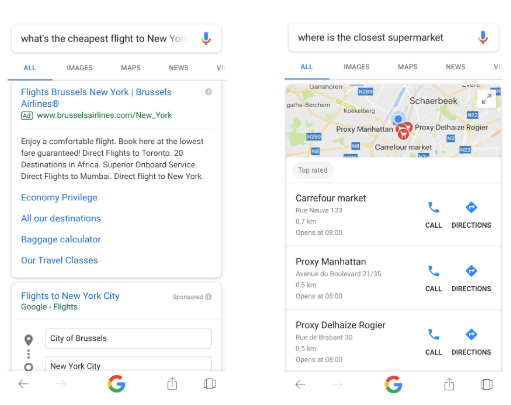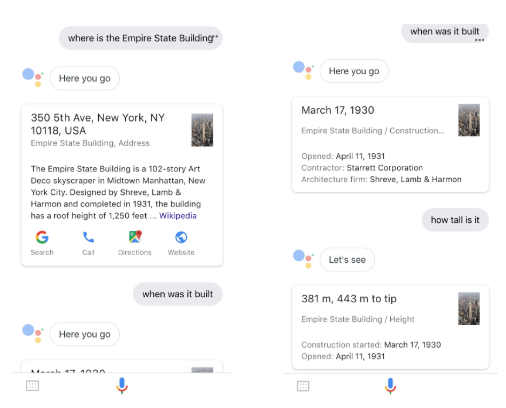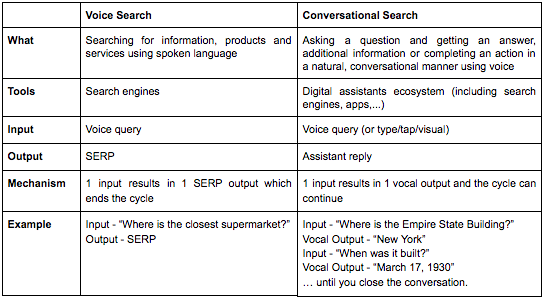Have you ever found yourself in a situation where you needed instant access to information but were on the go or just too busy? Just like many others, you probably turned to your mobile phone and searched the web to find what you were looking for. It’s all about convenience and the mobile experience pretty much does the trick.
Over the last few years, mobile technology has evolved to fulfill this need for more convenience. New ways of searching and interacting with mobile devices have arisen, allowing the users to get information or complete daily tasks in a more natural way by using alternative input methods such as voice commands.
Voice technology is growing fast and represents an important turning point in the way consumers will expect to connect with brands. By 2020, 50% of all searches will be done through voice. Voice is the future of search and this future has already started now.
As a result, voice search, chatbots, smart speakers, digital assistants like Google Assistant, Alexa, Cortana, Siri, ... are clearly becoming more than new buzzwords in the digital world.
Voice is about customized convenience
With the new possibilities that come with new mobile technologies, expectations evolve. Users expect to get personalized and direct answers, and they care about convenience.
That’s pretty much what voice technology has to offer. Voice technology is the practice of communicating with a search engine, website or app by only using spoken language. Speech is converted into computer query and the AI powering smart assistants is then able to process and complete users’ vocal requests, like playing their favorite music, searching online, setting their alarm, ordering a new product, ...
Today, more and more people are integrating voice-activated devices in their everyday lives. Early January, Google said it sold ‘more than one Google Home device every second since Google Home Mini started shipping in October.’ Smart speakers have started to fill in the houses and are pushing these expectations and behaviors by making daily routines easier. It becomes natural. By the way, 72% of people in the U.S. owning a voice-activated speaker say that their device is part of their daily routine.
What does it mean for you as a business? It represents new opportunities but also challenges. You may want to jump onto this transition before competition does. A good place to start is understanding the basics, the technologies and how it will affect the way users can interact with your brand.
Voice Search vs Conversational Search, a blurred line
The voice landscape is still growing and rapidly evolving. That’s why we took it upon ourselves to try and map what’s out there, to help us, and you, understand what to do next.
You have probably heard about the concepts of voice and conversational search. Both leverage the AI capabilities of speech recognition and natural language processing to turn user’s speech into text that is then turned into queries understandable by machines (smartphone, smart speaker, …). Even though they might seem the same, they’re not. Voice search and conversational search differ in terms of user interaction, in the way their technology delivers output to answer a user’s request.
Voice search is a technology that enables users to search for information, products or services via search engines using spoken language. It recognizes and translates speech into computer query. The machine algorithm processes it and eventually returns output listed in a search engine results page.
For example, with a simple click on the microphone, you can ask Google Search ‘where is the closest supermarket?’ or ‘what’s the cheapest flight to New York at the moment?’ and you will get a SERP as you usually get on Google Search.

Here, the combination of voice and mobile technologies makes the results relevant to your current context and location.
Conversational search is a technology that enables users to ask a question, additional information or to complete an action via a digital or smart assistant, by using their voice in a natural, conversational manner. It recognizes and processes user speech, translates it into computer query and returns one vocal output before letting the user follow up with another query or close the conversation.
For example, you can ask ‘where is the Empire State Building?’ to your Google Assistant app and you will get an instant vocal answer. Then you can follow up by asking ‘When was it built?’ and ‘How tall is it?’.

Here, voice technology translates vocal input into an understandable web query. Then, machine learning processes the query and enables the assistant software to understand the context and follow up, knowing that you are still referring to the Empire State Building with your following questions.
To make it more concise, here below is an overview of how we interpret and understand the basic components of voice landscape at this stage.

What about your digital strategy? SEO vs SEA vs Applications
The shift in the way people are searching, from text to vocal, and their expectations for more personalized instant answers will require to rethink your digital approach, especially in terms of content optimization and web indexing.
Here you can see which of your digital activities will be affected by the use of voice technologies.

SEA: With voice search, optimal SEA strategies will need to address longer-tail and precise queries, often turned in a question form and more local. Mobile voice-related searches are 3X more likely to be local-based than text-related searches. Thinking local and automation will be the main enablers, and many automated solutions can help you with it, like smart bidding, ad customizers or feed-based ads.
SEO: As of January 2018, there were an estimated one billion voice searches per month. This trend will impact the way of building and structuring web content. With voice, ranking first is even more important.
- Focusing on user intent and context elements by performing semantic search rather than keyword search only;
- Writing content in a conversational form to answer question-like queries in a natural way (e.g. creating FAQ sections);
- Adding structured and informational data that help the algorithm crawling your content more efficiently and focus on featured snippets, direct answers or knowledge graph integrations.
All these aspects will be worth considering to help your brand ranking at the top in voice search results.
Apps: Smart assistants are learning with every user interaction. As a brand, the opportunity you have now is to be a frontrunner in this realm and integrate this touch point within your consumer journey.
Let’s consider Google technologies here. On top of the built-in connections that the Google Assistant has with its own ecosystem and other apps (like your gmail inbox, your calendar, Google search engine, Google map, Spotify, …), the option you have as a business is to develop your own assistant/chatbot. A conversational agent that the Google Assistant will call on when asked questions related to your business.
It will require designing your own conversational flow based on the way your users want to interact with you and the questions they might ask through voice. It is an opportunity to highlight your brand personality by building your own voice and assisting users with convenient and personalised solutions where and when they need it.
All three elements will be indispensable as part of a business strategy to adopt voice technologies.
Conclusion
In brief, voice technologies are growing fast and are rapidly altering the way users search and expect to get information. Users expect to connect with brands in a more natural, personal and conversational way, without any friction. They expect brands to offer them convenient solutions that assist and delight them in their daily lives.
As a business, it is the perfect time to consider conversational interactions supported by voice technologies as a part of your consumer journey. Start by understanding the basics of voice and assistant technologies, how they work and how they will affect your digital approach.
Now is the right time to start experimenting, learning and building your own voice!



